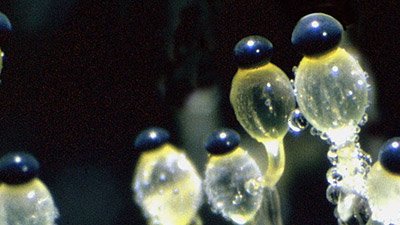
Fungal “family tree” identifies problems with evolution
The scientific journal Nature featured an article1 on the attempt to reconstruct a phylogenetic tree (line of descent) for the kingdom Fungi, utilizing six genes. The rationale for this study was to use this analysis to provide insights into the possible evolution of other species, including man. This research was funded by the National Science Foundation’s “Assembling the Tree of Life” and “Research Coordination Network” programs. Their hope is that research of this kind will answer the most basic questions about how life evolved on earth.
In an article that appeared in Oregon’s Medford News,2 the research was praised as being vital for our understanding of the fungi—a group of organisms that are of both medical and agricultural importance, as well as being crucial for the breakdown of plant and animal wastes. But what did the Nature article really say? Does this research hold the potential to vindicate the theory of biological evolution?
A closer look at both the news report and the scientific article reveals no such vindication. The Medford News article merely served as a propaganda piece, mixing biological facts about the Kingdom Fungi with conjecture (i.e., the claim that they “may have helped other life forms colonize the land”). The paper also interviewed one of the co-authors of this study, and reported his evolutionary beliefs as fact.
The Nature article was the product of 60 authors from 35 institutions, including Duke University, Oregon State University, USDA, and the Field Museum of Natural History in Chicago, as well as researchers from around the world.
In order to construct a phylogeny for the fungi, the authors analyzed the sequences of six genes shared by 199 species of fungi and compared them to sequences from 15 non-fungal species (including human beings). The genes chosen for this analysis participate in core cellular functions; therefore evolutionists believe the sequences are somewhat related.
The authors used complex mathematical algorithms to align the sequences for all 214 organisms, and used a weighted scale to assign values for differences in DNA sequence between species for each gene. Using this approach, the authors were able to classify the fungi into taxonomic classes, with good support for relatedness within the phyla Ascomycota (penicillin-producing mold, baker’s yeast), the Basidiomycota (mushrooms), and the Glomeromycota (mycorhizae—plant symbionts). The last two phyla, Zygomycota (black bread mold) and Chytridiomycota (flagellar fungi) posed significant challenges to the construction of this phylogenetic tree due to their intermingling.
The challenges encountered by these researchers resulted directly from their presuppositional belief that all organisms on earth are related and can be traced back to one common ancestor. This is evidenced by their opening statement: “Fungi, Viridiplantae and Animalia are all large clades descended from unicellular, flagellated, aquatic forms that radiated extensively on land.” However, it is just as likely that members of these phyla share common gene sequences because they were created by a common Designer, an observation that was not even broached in the article.
First, the authors note that the Chytridiomycota (a group of fungi believed to be the most ancient and progenitor of all other fungi) are not members of one phyletic group (i.e., monophyletic). The Chytridiomycota consist of fungi that produce spores that possess flagella, allowing them to be motile in water. This property is not unique to fungi, as various plant and animal species also possess this trait. The interesting conundrum is that, based on the sequence of the genes used in this study, the Chytridiomycota group is in up to six different clades, including the Zygomycota and the even more (supposedly) ancient microsporidia (obligately parasitic fungal-like organisms).
Because of these groupings, the authors propose that the fungi lost the ability to produce flagella (and subsequently gained new spore dispersal abilities) 4–6 times over the course of their evolution. While the loss of flagella is totally understandable in the light of biblical creation (see How manatees lost their legs? for a related example), the gaining of 4–6 unique and completely new methods of spore dispersal is statistically remote at best. It is a “just-so” story with no evidence other than that it is the simplest explanation within the evolution paradigm.
The second finding involves the placement of the microsporidia, defined as “obligately endoparasitic, protist-like organisms with highly reduced morphology and genomes.”3 The authors note that this group of organisms had previously been placed in the fungi due to their cellular characteristics, but this may be incorrect due to their apparent accelerated rate of gene sequence mutation. In the present study, the authors had trouble placing the microsporidia into a particular phyletic group, but state that based on sequence divergence, they should be considered as the most ancient of the fungal species.
Herein lies the problem with their worldview in interpreting this data: since they assume relatedness of all species, they must shoehorn both the microsporidia and Chytridiomycota into their phylogenetic tree. It is more likely that these groups of organisms represent distinctly created baramins (kinds) as stated in Genesis.
The fact that the Ascomycota, Basidiomycota, and Glomerulomycota did fall into distinct groups in their proposed phylogenetic tree supports the creationist theory of created kinds. These fungi are outwardly very different, using different modes of spore dispersal, different mating schemes (e.g., ascomycetes have two mating types, similar to male and female, whereas basidiomycetes can have many hundreds of mating types), and are reproductively isolated from each other. It is quite likely that these phyla represent three originally created kinds of fungi.
In summary, the research outlined in these articles does little to support molecules-to-man evolution as a theory of origins. Since this type of research is historical in nature, the conclusions made by the authors are their guesses given their naturalistic worldview. When interpreted in a biblical creationist framework, however, these kinds of studies may provide insight in determining the genetic complement of the originally created kinds of organisms that entered the world on days 3–6 of Creation Week.
By submitting to the authority of the One who was there at the beginning, we may find answers to a number of genetic diseases, as well as answers to questions regarding relationships between organisms and the rise of infectious diseases.
*This is a pseudonym. The writer, who holds a Ph.D. in a field related to the topic of this article, is a scientist at a prominent research facility in the eastern part of North America. He prefers to keep his creationist credentials hidden for the moment until he achieves more seniority. Return.
Footnotes
- T.Y. James, F. Kauff, C.L. Schoch, P.B. Matheny, V. Hofstetter, C.J. Cox, G. Celio, C. Gueidan, E. Fraker, J. Miadlikowska, H.T. Lumbsch, A. Rauhut, V. Reeb, A.E. Arnold, A. Amtoft, J.E. Stajich, K. Hosaka, G.H. Sung, D. Johnson, B. O’Rourke, M. Crockett, M. Binder, J.M. Curtis, J.C. Slot, Z. Wang, A.W. Wilson, A. Schussler, J.E. Longcore, K. O’Donnell, S. Mozley-Standridge, D. Porter, P.M. Letcher, M.J. Powell, J.W. Taylor, M.M. White, G.W. Griffith, D.R. Davies, R.A. Humber, J.B. Morton, J. Sugiyama, A.Y. Rossman, J.D. Rogers, D.H. Pfister, D. Hewitt, K. Hansen, S. Hambleton, R.A. Shoemaker, J. Kohlmeyer, B. Volkmann-Kohlmeyer, R.A. Spotts, M. Serdani, P.W. Crous, K.W. Hughes, K. Matsuura, E. Langer, G. Langer, W.A. Untereiner, R. Lucking, B. Budel, D.M. Geiser, A. Aptroot, P. Diederich, I. Schmitt, M. Schultz, R. Yahr, D.S. Hibbett, F. Lutzoni, D.J. McLaughlin, J.W. Spatafora, and R. Vilgalys, “Reconstructing the early evolution of Fungi using a six-gene phylogeny,” Nature 443:818–22, 2006.
- Oregon Professor Co-Authors Study On Evolution of Fungi,” Medford News, October 30, 2006.
- P.J. Keeling and N.M. Fast, in F.E. Vega and M. Blackwell (eds.), Insect-Fungal Associations: Ecology and Evolution (Oxford: Oxford University Press, 2005), pp. 97–118.
Recommended Resources

Answers in Genesis is an apologetics ministry, dedicated to helping Christians defend their faith and proclaim the good news of Jesus Christ.
- Customer Service 800.778.3390
- Available Monday–Friday | 9 AM–5 PM ET
- © 2026 Answers in Genesis




